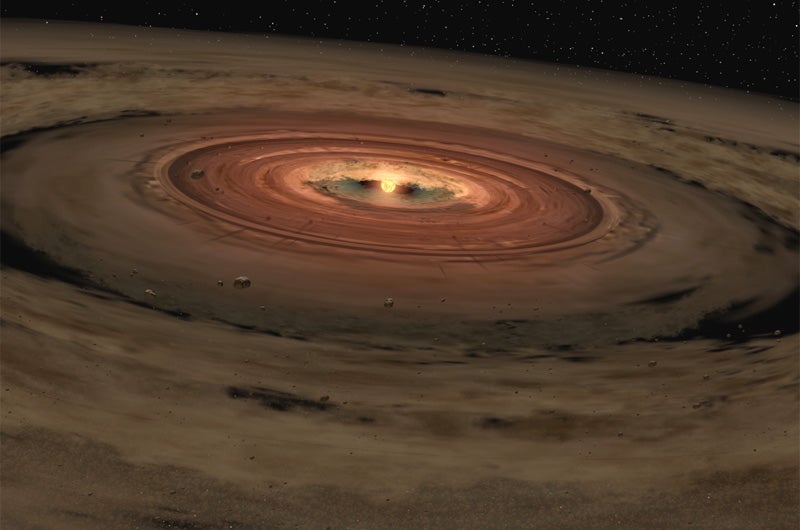Some like it hot
ListenAstronomers now ‘mapping’ brightness variations in stellar atmospheres. T-class “star” Luhman16B is a type of brown dwarf star, 13 to 90 times the mass of Jupiter or up to 1/10 of the sun, aren’t big enough to become stars – they don’t burn. L-16B, 6.6 light years from Earth shows an atmosphere of hydrogen but at 2,000 degrees F, it also has droplets of liquid iron and other minerals! M-class stars are the most numerous in the universe but are the lowest temperature star that can actually ‘burn’ – that is, fuse hydrogen. Three lower temperature-class (L, T, Y class) objects have temps as low as a household oven. Not really stars but more like hot Jupiters. Also, If a ‘blue moon’ refers the occurrence of two full moons in a month, what do you call a month with no new moon? – February 2014: weird!
February 3, 2014
[Dave Heller] The occasional polar vortex and heat wave notwithstanding, our tristate region enjoys temperatures conducive to four seasons of fairly even duration. Let’s sing the praises of our sun and contrast it with other suns with Derrick Pitts, chief astronomer at the Franklin Institute. Derrick, we don’t have to dig too deep — let’s just scratch the surface of ours and other suns.
[Derrick Pitts] I think we’re pretty happy with our star as it is. It works pretty well for us and it makes sense, of course, because life on this planet has evolved under this star. So it all makes sense that we’re happy and comfortable with a star that’s about 93 million miles away from us, with a surface temperature of about 11,000 degrees. Ours is a typical sort of a star — not too big, not too small. It’s very, very average. However there are plenty of objects around in the night sky that are sort of untypical, but we still use the term “star”; and when I say untypical, I mean their temperatures are very, very far off, in fact, quite low to be really considered a star.
-
This video of the sun based on data from NASA’s Solar Dynamics Observatory, or SDO, shows the wide range of wavelengths — invisible to the naked eye — that the telescope can view. SDO converts the wavelengths into an image humans can see, and the light is colorized into a rainbow of colors. As the colors sweep around the sun in the movie, viewers should note how different the same area of the sun appears. This happens because each wavelength of light represents solar material at specific temperatures. Different wavelengths convey information about different components of the sun’s surface and atmosphere, so scientists use them to paint a full picture of our constantly changing and varying star. The 2.9 minute movie was created by NASA’s Scientific Visualization Studio or SVS at NASA’s Goddard Space Flight Center in Greenbelt, Maryland.
What’s the minimum requirement for a star?
Actually, the minimum requirement for a star is that you have a dense gaseous object that is converting hydrogen to helium in some sort of a nuclear fusion process. Now the coolest stars that can do this are recognized to be in what is known as the M-Class. M-Class are very, very cool red stars that have a pretty low temperature, maybe 6,000 degrees or so, 4 – 6,000 degrees. But still they have enough density going on at their core that they can fuse hydrogen, and that makes them a star. There does happen to be a class of objects down below that, that although they are spherical like a star might be and have some temperature, really can’t be stars because they have no nuclear fusion process going on.
Nor are they planets though?
Well, that’s a really great question. And this is one of the things that astronomers are trying to figure out is that these objects seem to occupy a space between being a planet and being a star. They’re not small enough or cool enough really to be a planet, maybe, but they’re really not hot enough at all to be a star. So we have classes for these. There are what are called L-type, T-type and Y-type stars. And they occupy a class that we call Brown Dwarf stars. Now, “brown” because they are very, very cool; the warmest of these might be up to 3,000 degrees or so, just under the M-Class of 4,000. And the coolest of these are down to the temperature of a household oven, maybe even human body temperature. So now where do they fall in this class of objects? Well you might surmise that the ones that are the coolest ones might be more like planets. Some of them might be more like what are now being called “Hot Jupiters” — very, very large, about the size of our planet Jupiter or a few times larger, with temperatures up to 1,000 or 1,500 degrees or so. But all in this very interesting class of not quite a planet, not quite a star.
You’ve taught us repeatedly that the hot stars burn bright but don’t live very long. By contrast, do these cooler ones just go and go and go?
It seems as if they just go and go and go. In fact, it’s something that’s still remaining to be seen, because it was only about 20 years ago that the first Brown Dwarf stars, if you will, Brown Dwarf objects, were actually confirmed to exist. So now we have an opportunity to look around and see if we can find more of these and determine from a survey of different objects at different ages or stages just what happens to them exactly.
-

This artist’s concept shows a brown dwarf surrounded by a swirling disk of planet-building dust. NASA’s Spitzer Space Telescope spotted such a disk around a surprisingly low-mass brown dwarf, or “failed star.” Astronomers believe that this unusual system will eventually spawn planets. If so, they speculate the disk has enough mass to make one small gas giant and a few Earth-sized rocky planets. Image Credit: NASA/JPL
What’s the best hunch on the eventual fate of our star? Will it get hotter or cooler?
What’s actually going to happen with our star is that it will swell in size. As it gets older it will expand out to be about the size of the orbit of Mars.
Wait a minute — we’re within that orbit!
Yes that’s right, so things are going to get very, very hot here. In fact, our planet and the other three planets of the inner solar system will be inside the envelope of our star — we’ll be inside. So that means that we will melt away; of course, all of our oceans boil and everything else. Planets like Jupiter, Saturn, Uranus and Neptune will change their states entirely, because as planets made of frozen gas, they will all melt out and become something totally different. And then eventually our star will shrink down to become close to what’s a white dwarf star and that will signal the end of our lifetime of our star.
So when is that likely to happen?
Our sun right now is about halfway through the mature section of its life. So, it’s about 5 billion years old. It will remain as we see it now for probably another 5 billion years — thank goodness! — and then it will start to evolve and become something totally different. If we look at the star Betelgeuse in the night sky, we can see something that’s akin to what our star will look like, turning into a red giant star. But, as I said, not for another 5 billion years do we need to worry about that.
Let’s continue looking aloft: What’s available in the night sky this week?
Planets, planets, beautiful planets! In fact, tonight, tomorrow night and Wednesday evening about 45 minutes after sunset over in the southwestern horizon, tiny but bright Mercury will be visible. Probably one of the best views of Mercury we’ll have this year. But if you’d like to other planets, in the morning sky about 45 minutes before sunrise in the southeast — brilliant Venus is available! If neither one of those times works for you, Jupiter is high in the evening sky after sunset without any problem at all. And then also in the predawn sky we find Mars and Saturn.
Say, what color is the moon this month?
[Laughs] Ah, yes, well — depends on which phase you’re talking about. If you’re talking about full moon, looks like normal, but for new moon it will be a dark moon indeed. Because as it turns out, this month of February there is no new moon at all!
That doesn’t happen but once in a blue moon, does it?
Great question, but in fact no. It’s kind of unusual to have a month where there’s no new moon at all. But if we just think about it for half a second, it can easily make sense. February is a month with 28 days, the cycle of the moon is 29.5, so if the cycle of moon-phasing begins in such a way that the new moon comes early in the month, particularly in January, then the possibility for that happening becomes quite large, in fact. Because here we have a situation where we had new moon in January, new moon again late in January, so there’s no new moon in February — in fact the new moon that follows the month comes right on March 1.
WHYY is your source for fact-based, in-depth journalism and information. As a nonprofit organization, we rely on financial support from readers like you. Please give today.




